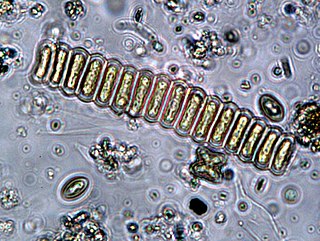Related Research Articles

In molecular biology, a stop codon is a codon that signals the termination of the translation process of the current protein. Most codons in messenger RNA correspond to the addition of an amino acid to a growing polypeptide chain, which may ultimately become a protein; stop codons signal the termination of this process by binding release factors, which cause the ribosomal subunits to disassociate, releasing the amino acid chain.

In biology, translation is the process in living cells in which proteins are produced using RNA molecules as templates. The generated protein is a sequence of amino acids. This sequence is determined by the sequence of nucleotides in the RNA. The nucleotides are considered three at a time. Each such triple results in addition of one specific amino acid to the protein being generated. The matching from nucleotide triple to amino acid is called the genetic code. The translation is performed by a large complex of functional RNA and proteins called ribosomes. The entire process is called gene expression.

Scenedesmus is a genus of green algae, in the class Chlorophyceae. They are colonial and non-motile.

MT-ND6 is a gene of the mitochondrial genome coding for the NADH-ubiquinone oxidoreductase chain 6 protein (ND6). The ND6 protein is a subunit of NADH dehydrogenase (ubiquinone), which is located in the mitochondrial inner membrane and is the largest of the five complexes of the electron transport chain. Variations in the human MT-ND6 gene are associated with Leigh's syndrome, Leber's hereditary optic neuropathy (LHON) and dystonia.
The pterobranchia mitochondrial code is a genetic code used by the mitochondrial genome of Rhabdopleura compacta (Pterobranchia). The Pterobranchia are one of the two groups in the Hemichordata which together with the Echinodermata and Chordata form the three major lineages of deuterostomes. AUA translates to isoleucine in Rhabdopleura as it does in the Echinodermata and Enteropneusta while AUA encodes methionine in the Chordata. The assignment of AGG to lysine is not found elsewhere in deuterostome mitochondria but it occurs in some taxa of Arthropoda. This code shares with many other mitochondrial codes the reassignment of the UGA STOP to tryptophan, and AGG and AGA to an amino acid other than arginine. The initiation codons in Rhabdopleura compacta are ATG and GTG.
The yeast mitochondrial code is a genetic code used by the mitochondrial genome of yeasts, notably Saccharomyces cerevisiae, Candida glabrata, Hansenula saturnus, and Kluyveromyces thermotolerans.
The mold, protozoan, and coelenterate mitochondrial code and the mycoplasma/spiroplasma code is the genetic code used by various organisms, in some cases with slight variations, notably the use of UGA as a tryptophan codon rather than a stop codon.
The invertebrate mitochondrial code is a genetic code used by the mitochondrial genome of invertebrates.
The echinoderm and flatworm mitochondrial code is a genetic code used by the mitochondria of certain echinoderm and flatworm species.
The ascidian mitochondrial code is a genetic code found in the mitochondria of Ascidia.
The alternative flatworm mitochondrial code is a genetic code found in the mitochondria of Platyhelminthes and Nematodes.
The chlorophycean mitochondrial code is a genetic code found in the mitochondria of Chlorophyceae.
The trematode mitochondrial code is a genetic code found in the mitochondria of Trematoda.
Scenedesmus obliquus is a green algae species of the genus Scenedesmus.
The Thraustochytrium mitochondrial code is a genetic code found in the mitochondria of the labyrinthulid protist Thraustochytrium aureum. The mitochondrial genome was sequenced by the Organelle Genome Megasequencing Program.
The pachysolen tannophilus nuclear code is a genetic code found in the ascomycete fungus Pachysolen tannophilus.
The karyorelictid nuclear code is a genetic code used by the nuclear genome of the Karyorelictea ciliate Parduczia sp.
The Blastocrithidia nuclear code is a genetic code used by the nuclear genome of the trypanosomatid genus Blastocrithidia.
The Cephalodiscidae mitochondrial code is a genetic code used by the mitochondrial genome of Cephalodiscidae (Pterobranchia). The Pterobranchia are one of the two groups in the Hemichordata which together with the Echinodermata and Chordata form the major clades of deuterostomes.
References
This article incorporates text from the United States National Library of Medicine, which is in the public domain. [2]
- 1 2 A. M. Nedelcu, R. W. Lee, G. Lemieux, M. W. Gray, G. Burger (June 2000). "The complete mitochondrial DNA sequence of Scenedesmus obliquus reflects an intermediate stage in the evolution of the green algal mitochondrial genome". Genome Research. 10 (6): 819–31. doi:10.1101/gr.10.6.819. PMC 310893 . PMID 10854413.
{{cite journal}}: CS1 maint: multiple names: authors list (link) - ↑ Elzanowski A, Ostell J, Leipe D, Soussov V. "The Genetic Codes". Taxonomy browser. National Center for Biotechnology Information (NCBI), U.S. National Library of Medicine. Retrieved 11 August 2016.